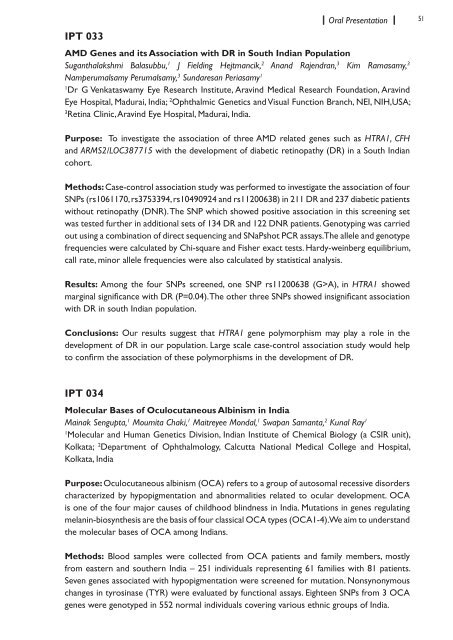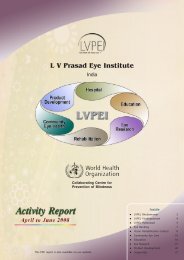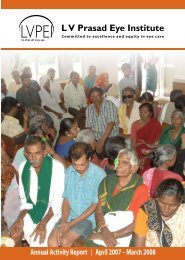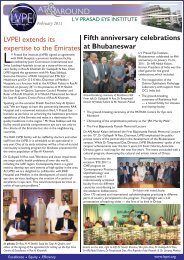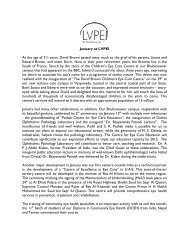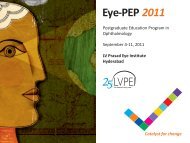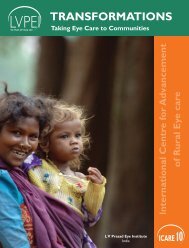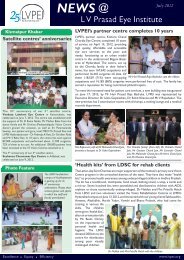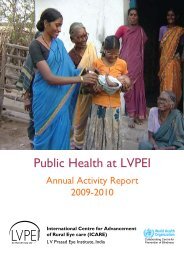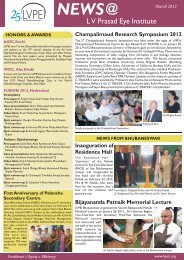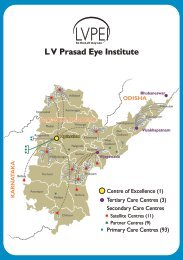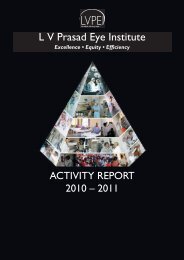IERG Abstracrt Book.indd - LV Prasad Eye Institute
IERG Abstracrt Book.indd - LV Prasad Eye Institute
IERG Abstracrt Book.indd - LV Prasad Eye Institute
You also want an ePaper? Increase the reach of your titles
YUMPU automatically turns print PDFs into web optimized ePapers that Google loves.
IPT 033Oral Presentation51AMD Genes and its Association with DR in South Indian PopulationSuganthalakshmi Balasubbu, 1 J Fielding Hejtmancik, 2 Anand Rajendran, 3 Kim Ramasamy, 3Namperumalsamy Perumalsamy, 3 Sundaresan Periasamy 11Dr G Venkataswamy <strong>Eye</strong> Research <strong>Institute</strong>, Aravind Medical Research Foundation, Aravind<strong>Eye</strong> Hospital, Madurai, India; 2 Ophthalmic Genetics and Visual Function Branch, NEI, NIH,USA;3Retina Clinic, Aravind <strong>Eye</strong> Hospital, Madurai, India.Purpose: To investigate the association of three AMD related genes such as HTRA1, CFHand ARMS2/LOC387715 with the development of diabetic retinopathy (DR) in a South Indiancohort.Methods: Case-control association study was performed to investigate the association of fourSNPs (rs1061170, rs3753394, rs10490924 and rs11200638) in 211 DR and 237 diabetic patientswithout retinopathy (DNR). The SNP which showed positive association in this screening setwas tested further in additional sets of 134 DR and 122 DNR patients. Genotyping was carriedout using a combination of direct sequencing and SNaPshot PCR assays. The allele and genotypefrequencies were calculated by Chi-square and Fisher exact tests. Hardy-weinberg equilibrium,call rate, minor allele frequencies were also calculated by statistical analysis.Results: Among the four SNPs screened, one SNP rs11200638 (G>A), in HTRA1 showedmarginal significance with DR (P=0.04). The other three SNPs showed insignificant associationwith DR in south Indian population.Conclusions: Our results suggest that HTRA1 gene polymorphism may play a role in thedevelopment of DR in our population. Large scale case-control association study would helpto confirm the association of these polymorphisms in the development of DR.IPT 034Molecular Bases of Oculocutaneous Albinism in IndiaMainak Sengupta, 1 Moumita Chaki, 1 Maitreyee Mondal, 1 Swapan Samanta, 2 Kunal Ray 11Molecular and Human Genetics Division, Indian <strong>Institute</strong> of Chemical Biology (a CSIR unit),Kolkata; 2 Department of Ophthalmology, Calcutta National Medical College and Hospital,Kolkata, IndiaPurpose: Oculocutaneous albinism (OCA) refers to a group of autosomal recessive disorderscharacterized by hypopigmentation and abnormalities related to ocular development. OCAis one of the four major causes of childhood blindness in India. Mutations in genes regulatingmelanin-biosynthesis are the basis of four classical OCA types (OCA1-4). We aim to understandthe molecular bases of OCA among Indians.Methods: Blood samples were collected from OCA patients and family members, mostlyfrom eastern and southern India – 251 individuals representing 61 families with 81 patients.Seven genes associated with hypopigmentation were screened for mutation. Nonsynonymouschanges in tyrosinase (TYR) were evaluated by functional assays. Eighteen SNPs from 3 OCAgenes were genotyped in 552 normal individuals covering various ethnic groups of India.


